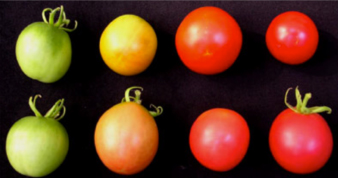
“What I find most amazing about plants is that they’re a great source for thousands and thousands of chemicals,” says Dr. Asaph Aharoni of the Weizmann Institute of Science’s Department of Plant Sciences. “A single plant can produce 10,000 to 20,000 metabolites, or active compounds, which we can use for nutrition and in products like drugs and cosmetics.”
Dr. Aharoni studies how plants regulate the production of metabolites during development and under conditions of stress, such as insect attack or exposure to ultraviolet (UV) radiation. His goal is to identify novel genes that are associated with, for example, better nutritional quality and enhanced resistance to insect pests. In the future, his findings could help scientists develop better crops. “We’re interested in how we can help address a major challenge: improving the nutritional quality of plants and solving problems of malnutrition around the world,” he says.
For a number of years, Dr. Aharoni has been investigating the process of tomato fruit maturation and ripening. During this process, the tomato fruit accumulates large amounts of carotenoids such as lycopene and beta-carotene. These compounds are antioxidants and are important in human nutrition. The body converts beta-carotene, for instance, into vitamin A, a nutrient that plays a key role in vision, bone growth, and regulating the immune system.
To understand how tomato ripening is triggered, Dr. Aharoni and his team alter the expression of certain genes that are involved in the process. “One of the ‘mutant’ tomatoes we created is highly interesting,” he says. “When we over-express a particular gene that is a regulator of the ripening process, it induces ripening and an accumulation of carotenoids in the sepals [a leaf-like part of the plant where carotenoids do not normally build up].”
Dr. Aharoni explains that research on the regulation of the pathways that generate lycopene and beta-carotene could lead to the engineering of crops with higher levels of these compounds. He notes that, according to a report by the World Health Organization, improved vitamin A nutrition could prevent approximately 1-2 million deaths annually among children under five years of age. Vitamin A deficiency greatly increases the risk of a child’s dying from an infectious disease such as measles.

His team is also working to learn how plants regulate the production of thiamin (vitamin B1). This vitamin helps the body convert carbohydrates into energy and is essential for the functioning of the nervous system, muscles, and heart. A few years ago, Dr. Aharoni and his colleagues identified a mechanism that regulates the levels of thiamin in plants. “This mechanism works like a thermostat. If we manipulate it, we can increase the amount of thiamin a plant produces. We were able to do this in a model plant called Arabidopsis thaliana, and now we hope to do it in rice.” Most of the naturally occurring thiamin in rice is in the outer parts of the grain, which are removed during the polishing process. As a result, in some developing countries—for example, in Asia, where polished white rice is the staple food—thiamin deficiency is a common health problem.
In recent work, Dr. Aharoni’s team discovered the gene that produces a variety of pink-skinned tomato. Pink tomatoes, which are particularly popular in the Middle East, have a slightly sweeter taste, a thinner skin, and contain less lycopene than red tomatoes. The scientists found that the relevant gene is a sort of “master switch” that regulates an entire network of other genes, overseeing the production and quantities of many metabolites in the tomato fruit. Now researchers can use this gene, known as SIMYB12, as a marker to predict the future color of a fruit in the very early stages of development, before the plant has even flowered. This could accelerate the creation of new tomato varieties, a process that normally takes a decade or more.
Dr. Aharoni received his MSc in agricultural science from the Hebrew University of Jerusalem and his PhD in plant sciences from Wageningen University in The Netherlands, joining the Weizmann Institute in 2004. Dr. Aharoni says he realized early in his career that he was drawn to basic research. “As a result, in my lab today, we’re tackling questions using basic research and applying what we’re learning to improve plant nutrition and our quality of life,” he says.
The Weizmann Institute is an ideal place to do such work, as it has a long history of research aimed at enhancing the nutritional quality of food crops, increasing their resistance to disease, and reducing the use of harmful fertilizers and herbicides. In coming years, this work will be one of the Institute’s highest priorities as its scientists respond to pressing global issues such as climate change, hunger, obesity, and malnutrition.
Dr. Asaph Aharoni’s research is supported by the Clore Center for Biological Physics; the Minna James Heineman Stiftung; and Roberto and Renata Ruhman, Brazil. Dr. Aharoni is the incumbent of the Adolfo and Evelyn Blum Career Development Chair of Cancer Research in Perpetuity.
